Byeongwook Kim
Unifying Uniform and Binary-coding Quantization for Accurate Compression of Large Language Models
Jun 04, 2025Abstract:How can we quantize large language models while preserving accuracy? Quantization is essential for deploying large language models (LLMs) efficiently. Binary-coding quantization (BCQ) and uniform quantization (UQ) are promising quantization schemes that have strong expressiveness and optimizability, respectively. However, neither scheme leverages both advantages. In this paper, we propose UniQuanF (Unified Quantization with Flexible Mapping), an accurate quantization method for LLMs. UniQuanF harnesses both strong expressiveness and optimizability by unifying the flexible mapping technique in UQ and non-uniform quantization levels of BCQ. We propose unified initialization, and local and periodic mapping techniques to optimize the parameters in UniQuanF precisely. After optimization, our unification theorem removes computational and memory overhead, allowing us to utilize the superior accuracy of UniQuanF without extra deployment costs induced by the unification. Experimental results demonstrate that UniQuanF outperforms existing UQ and BCQ methods, achieving up to 4.60% higher accuracy on GSM8K benchmark.
An Investigation of FP8 Across Accelerators for LLM Inference
Feb 03, 2025



Abstract:The introduction of 8-bit floating-point (FP8) computation units in modern AI accelerators has generated significant interest in FP8-based large language model (LLM) inference. Unlike 16-bit floating-point formats, FP8 in deep learning requires a shared scaling factor. Additionally, while E4M3 and E5M2 are well-defined at the individual value level, their scaling and accumulation methods remain unspecified and vary across hardware and software implementations. As a result, FP8 behaves more like a quantization format than a standard numeric representation. In this work, we provide the first comprehensive analysis of FP8 computation and acceleration on two AI accelerators: the NVIDIA H100 and Intel Gaudi 2. Our findings highlight that the Gaudi 2, by leveraging FP8, achieves higher throughput-to-power efficiency during LLM inference, offering valuable insights into the practical implications of FP8 adoption for datacenter-scale LLM serving.
To FP8 and Back Again: Quantifying the Effects of Reducing Precision on LLM Training Stability
May 29, 2024
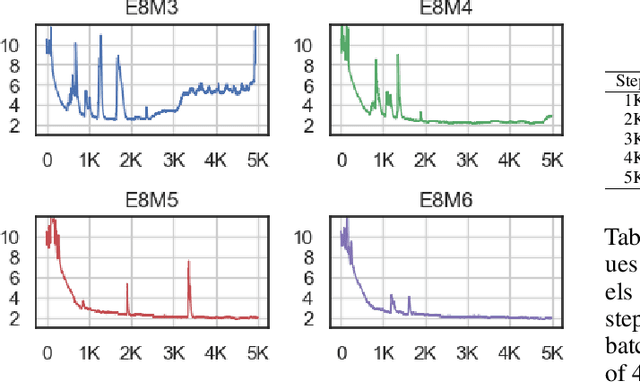
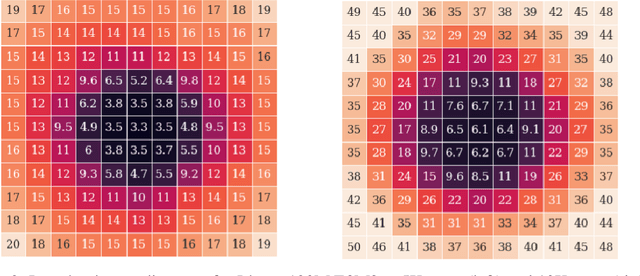

Abstract:The massive computational costs associated with large language model (LLM) pretraining have spurred great interest in reduced-precision floating-point representations to accelerate the process. As a result, the BrainFloat16 (BF16) precision has become the de facto standard for LLM training, with hardware support included in recent accelerators. This trend has gone even further in the latest processors, where FP8 has recently been introduced. However, prior experience with FP16, which was found to be less stable than BF16, raises concerns as to whether FP8, with even fewer bits than FP16, can be a cost-effective option for LLM training. We argue that reduced-precision training schemes must have similar training stability and hyperparameter sensitivities to their higher-precision counterparts in order to be cost-effective. However, we find that currently available methods for FP8 training are not robust enough to allow their use as economical replacements. This prompts us to investigate the stability of reduced-precision LLM training in terms of robustness across random seeds and learning rates. To this end, we propose new evaluation techniques and a new metric for quantifying loss landscape sharpness in autoregressive language models. By simulating incremental bit reductions in floating-point representations, we analyze the relationship between representational power and training stability with the intent of aiding future research into the field.
HyperCLOVA X Technical Report
Apr 13, 2024Abstract:We introduce HyperCLOVA X, a family of large language models (LLMs) tailored to the Korean language and culture, along with competitive capabilities in English, math, and coding. HyperCLOVA X was trained on a balanced mix of Korean, English, and code data, followed by instruction-tuning with high-quality human-annotated datasets while abiding by strict safety guidelines reflecting our commitment to responsible AI. The model is evaluated across various benchmarks, including comprehensive reasoning, knowledge, commonsense, factuality, coding, math, chatting, instruction-following, and harmlessness, in both Korean and English. HyperCLOVA X exhibits strong reasoning capabilities in Korean backed by a deep understanding of the language and cultural nuances. Further analysis of the inherent bilingual nature and its extension to multilingualism highlights the model's cross-lingual proficiency and strong generalization ability to untargeted languages, including machine translation between several language pairs and cross-lingual inference tasks. We believe that HyperCLOVA X can provide helpful guidance for regions or countries in developing their sovereign LLMs.
No Token Left Behind: Reliable KV Cache Compression via Importance-Aware Mixed Precision Quantization
Feb 28, 2024



Abstract:Key-Value (KV) Caching has become an essential technique for accelerating the inference speed and throughput of generative Large Language Models~(LLMs). However, the memory footprint of the KV cache poses a critical bottleneck in LLM deployment as the cache size grows with batch size and sequence length, often surpassing even the size of the model itself. Although recent methods were proposed to select and evict unimportant KV pairs from the cache to reduce memory consumption, the potential ramifications of eviction on the generative process are yet to be thoroughly examined. In this paper, we examine the detrimental impact of cache eviction and observe that unforeseen risks arise as the information contained in the KV pairs is exhaustively discarded, resulting in safety breaches, hallucinations, and context loss. Surprisingly, we find that preserving even a small amount of information contained in the evicted KV pairs via reduced precision quantization substantially recovers the incurred degradation. On the other hand, we observe that the important KV pairs must be kept at a relatively higher precision to safeguard the generation quality. Motivated by these observations, we propose \textit{Mixed-precision KV cache}~(MiKV), a reliable cache compression method that simultaneously preserves the context details by retaining the evicted KV pairs in low-precision and ensure generation quality by keeping the important KV pairs in high-precision. Experiments on diverse benchmarks and LLM backbones show that our proposed method offers a state-of-the-art trade-off between compression ratio and performance, compared to other baselines.
DropBP: Accelerating Fine-Tuning of Large Language Models by Dropping Backward Propagation
Feb 27, 2024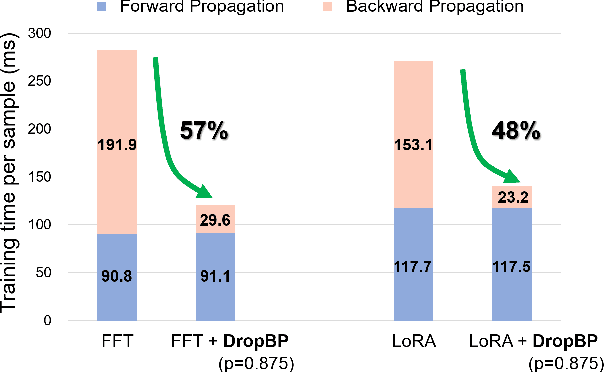

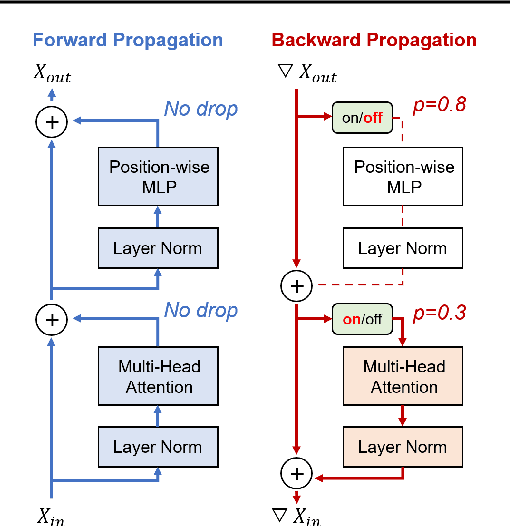

Abstract:Training deep neural networks typically involves substantial computational costs during both forward and backward propagation. The conventional layer dropping techniques drop certain layers during training for reducing the computations burden. However, dropping layers during forward propagation adversely affects the training process by degrading accuracy. In this paper, we propose Dropping Backward Propagation (DropBP), a novel approach designed to reduce computational costs while maintaining accuracy. DropBP randomly drops layers during the backward propagation, which does not deviate forward propagation. Moreover, DropBP calculates the sensitivity of each layer to assign appropriate drop rate, thereby stabilizing the training process. DropBP is designed to enhance the efficiency of the training process with backpropagation, thereby enabling the acceleration of both full fine-tuning and parameter-efficient fine-tuning using backpropagation. Specifically, utilizing DropBP in QLoRA reduces training time by 44%, increases the convergence speed to the identical loss level by 1.5$\times$, and enables training with a 6.2$\times$ larger sequence length on a single NVIDIA-A100 80GiB GPU in LLaMA2-70B. The code is available at https://github.com/WooSunghyeon/dropbp.
Rethinking Channel Dimensions to Isolate Outliers for Low-bit Weight Quantization of Large Language Models
Sep 27, 2023Abstract:Large Language Models (LLMs) have recently demonstrated a remarkable success across various tasks. However, efficiently serving LLMs has been a challenge due to its large memory bottleneck, specifically in small batch inference settings (e.g. mobile devices). Weight-only quantization can be a promising approach, but sub-4 bit quantization remains a challenge due to large-magnitude activation outliers. To mitigate the undesirable outlier effect, we first propose per-IC quantization, a simple yet effective method that creates quantization groups within each input channel (IC) rather than the conventional per-output channel (OC). Our method is motivated by the observation that activation outliers affect the input dimension of the weight matrix, so similarly grouping the weights in the IC direction can isolate outliers to be within a group. We also find that activation outliers do not dictate quantization difficulty, and inherent weight sensitivities also exist. With per-IC quantization as a new outlier-friendly scheme, we then propose Adaptive Dimensions (AdaDim), a versatile quantization framework that can adapt to various weight sensitivity patterns. We demonstrate the effectiveness of AdaDim by augmenting prior methods such as Round-To-Nearest and GPTQ, showing significant improvements across various language modeling benchmarks for both base (up to +4.7% on MMLU) and instruction-tuned (up to +10% on HumanEval) LLMs.
AlphaTuning: Quantization-Aware Parameter-Efficient Adaptation of Large-Scale Pre-Trained Language Models
Oct 08, 2022

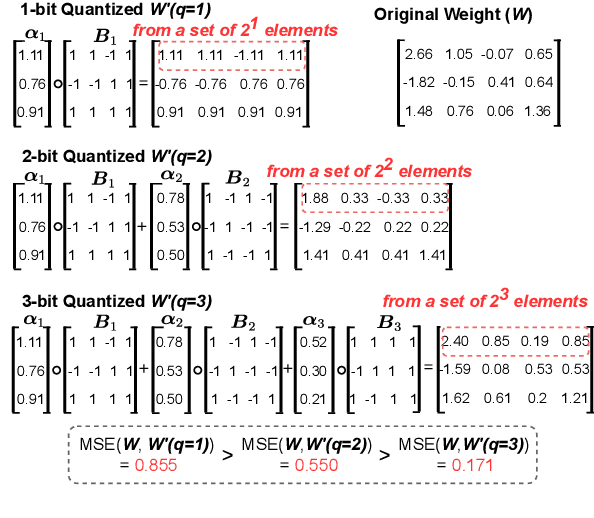
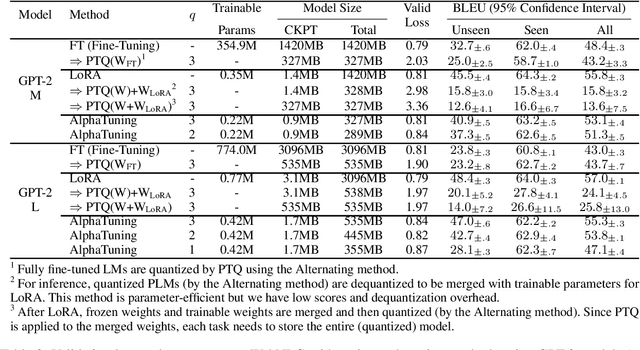
Abstract:There are growing interests in adapting large-scale language models using parameter-efficient fine-tuning methods. However, accelerating the model itself and achieving better inference efficiency through model compression has not been thoroughly explored yet. Model compression could provide the benefits of reducing memory footprints, enabling low-precision computations, and ultimately achieving cost-effective inference. To combine parameter-efficient adaptation and model compression, we propose AlphaTuning consisting of post-training quantization of the pre-trained language model and fine-tuning only some parts of quantized parameters for a target task. Specifically, AlphaTuning works by employing binary-coding quantization, which factorizes the full-precision parameters into binary parameters and a separate set of scaling factors. During the adaptation phase, the binary values are frozen for all tasks, while the scaling factors are fine-tuned for the downstream task. We demonstrate that AlphaTuning, when applied to GPT-2 and OPT, performs competitively with full fine-tuning on a variety of downstream tasks while achieving >10x compression ratio under 4-bit quantization and >1,000x reduction in the number of trainable parameters.
nuQmm: Quantized MatMul for Efficient Inference of Large-Scale Generative Language Models
Jun 20, 2022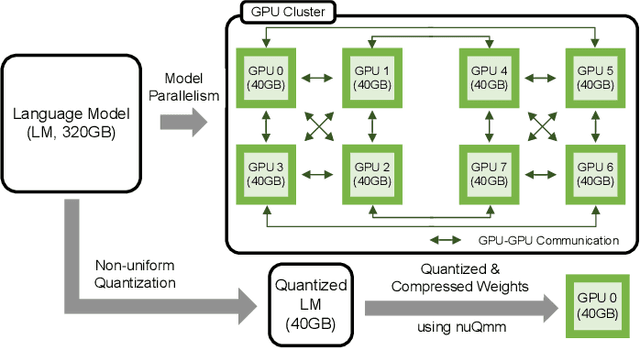



Abstract:The recent advance of self-supervised learning associated with the Transformer architecture enables natural language processing (NLP) to exhibit extremely low perplexity. Such powerful models demand ever-increasing model size, and thus, large amounts of computations and memory footprints. In this paper, we propose an efficient inference framework for large-scale generative language models. As the key to reducing model size, we quantize weights by a non-uniform quantization method. Then, quantized matrix multiplications are accelerated by our proposed kernel, called nuQmm, which allows a wide trade-off between compression ratio and accuracy. Our proposed nuQmm reduces the latency of not only each GPU but also the entire inference of large LMs because a high compression ratio (by low-bit quantization) mitigates the minimum required number of GPUs. We demonstrate that nuQmm can accelerate the inference speed of the GPT-3 (175B) model by about 14.4 times and save energy consumption by 93%.
Modulating Regularization Frequency for Efficient Compression-Aware Model Training
May 05, 2021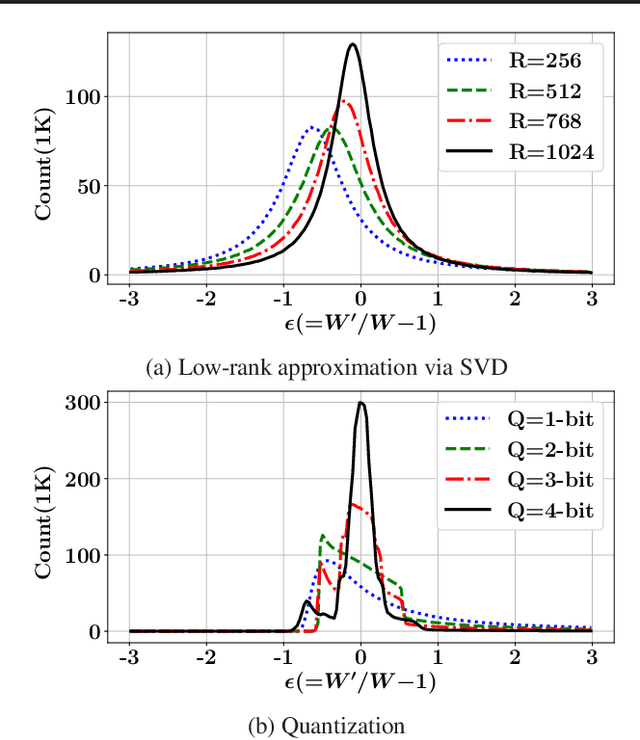
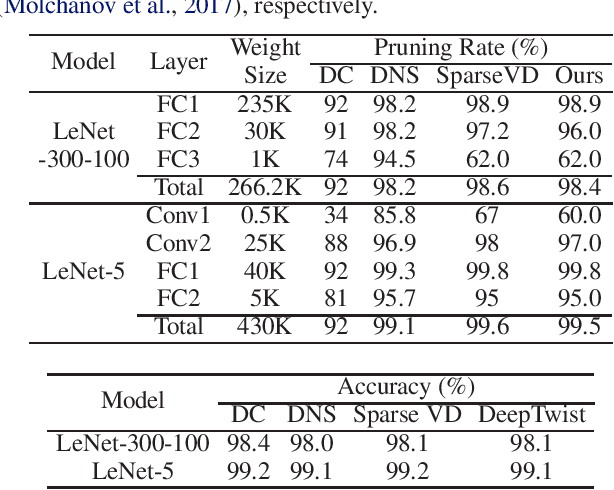
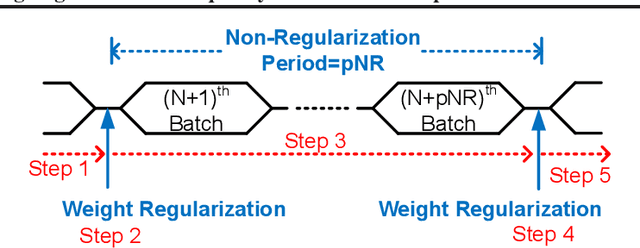

Abstract:While model compression is increasingly important because of large neural network size, compression-aware training is challenging as it needs sophisticated model modifications and longer training time.In this paper, we introduce regularization frequency (i.e., how often compression is performed during training) as a new regularization technique for a practical and efficient compression-aware training method. For various regularization techniques, such as weight decay and dropout, optimizing the regularization strength is crucial to improve generalization in Deep Neural Networks (DNNs). While model compression also demands the right amount of regularization, the regularization strength incurred by model compression has been controlled only by compression ratio. Throughout various experiments, we show that regularization frequency critically affects the regularization strength of model compression. Combining regularization frequency and compression ratio, the amount of weight updates by model compression per mini-batch can be optimized to achieve the best model accuracy. Modulating regularization frequency is implemented by occasional model compression while conventional compression-aware training is usually performed for every mini-batch.
 Add to Chrome
Add to Chrome Add to Firefox
Add to Firefox Add to Edge
Add to Edge